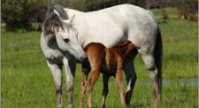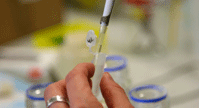Dog Coat color (S Locus) Parti, Piebald, or Random White Spotting
Description:
 There is no single basis for white spotted patterns that occur in animals like cats, dogs and horses. In horses, random white spotting, or deletions of color, have been determined to be caused by more than half a dozen known genetic factors. In more than 25 different dog breeds, a mutation found in a gene called the Microphthalmia Associated Transcription Factor-(MITF) is associated with a piebald spotting.
There is no single basis for white spotted patterns that occur in animals like cats, dogs and horses. In horses, random white spotting, or deletions of color, have been determined to be caused by more than half a dozen known genetic factors. In more than 25 different dog breeds, a mutation found in a gene called the Microphthalmia Associated Transcription Factor-(MITF) is associated with a piebald spotting.
In many breeds, piebald behaves as a “dosage”-dependent trait. This means that the amount of white a dog expresses depends on how many copies of the S locus allele a dog receives. Dogs like the French Bulldog who have a single copy of the MITF variant (S locus allele) will express a limited white spotting pattern. Dogs that have 2 copies (S/S) of the variant will exhibit more white with very little color. In some breeds, dogs that are coded as S/S are completely white, while dogs that are n/S have what is referred to as the mantle coloration. The mantle coloration is seen in several breeds of dogs, but is perhaps best exemplified by the Great Dane (black with a white chest/throat and feet).
As with horses and other animals, dog breeds with white spotting patterns or color deletion can be affected by additional mutations in the S locus and/or other genes that effect both coat color deletion and distribution. For example, the Irish spotting pattern (similar to mantle) seen in many breeds of dogs like Collies or Shelties is not caused by this mutation. Other examples include English Bulldogs that may test negative for the MITF variant but phenotypically look almost completely white. In minimally expressed pied French Bulldogs many test positive for only one copy of the MITF variant.
S Locus Testing:
Animal Genetics offers a test for the S-Locus to determine allele a dog is Parti, Piebald, or Random White Spotting Dogs can be DNA tested at ANY age.
Testing Is Relevant For The Following Breeds:
Australian Shepard, American Cocker Spaniel Basset Hound, Beagle, Border Collie, Boxer, French Bulldog, Cavalier King Charles Spaniel, Chihuahua, Chinese Shar-Pei, Dachshund, English Cocker Spaniel, German Longhaired Pointer, German Shorthaired Pointer, German Wirehaired Pointer, Goldendoodle, Havana Silk, Havanese, Labradoodle, Newfoundland/Landseer, Pointer, Poodle, Portuguese Water Dog, shetland sheepdog, Shar Pei, Saint Bernard, Whippet, Yorkshire Terrier
Sample Type:
Animal Genetics accepts buccal swab, blood, and dewclaw samples for testing. Sample collection kits are available and can be ordered at Canine Test Now.
Results:
Animal Genetics offers DNA testing specific for the mutation in MITF known to be associated with piebald/random white spotting. The genetic test verifies the presence of the mutation and presents results as one of the following. Note- white patterns will vary among individuals and from breed to breed.
* Additional causes of this trait exist. A negative result for this mutation does not eliminate the possibility that an additional, yet unidentified mutation or mutations in the genome may lead to a similar trait.
S-Allele Results:
| S/S | Piebald | The dog carries two copies of the MITF S allele. The dog may have limited coat color and will always pass on the "S" allele to any potential offspring. |
| n/S | Carrier | The dog carries a single copy of the S allele. In some breeds the dog may have limited random coat color deletion. The dog can pass on either allele to potential offspring. |
| n/ n | Negative | No copies of the MITF S allele where detected. The dog will not pass the MITF mutation on to offspring. Other yet unidentified causes of color deletion may exist. |
Submit a Sample for Testing:
To submit a sample for testing please go to Canine Test Now.
To order a sample collection kit please go to Order Sample Collection kits.
Cost per sample is $40.00. Please see our Canine Fee Schedule for all test rates.










